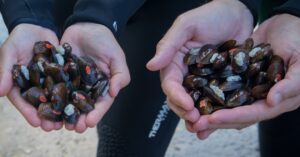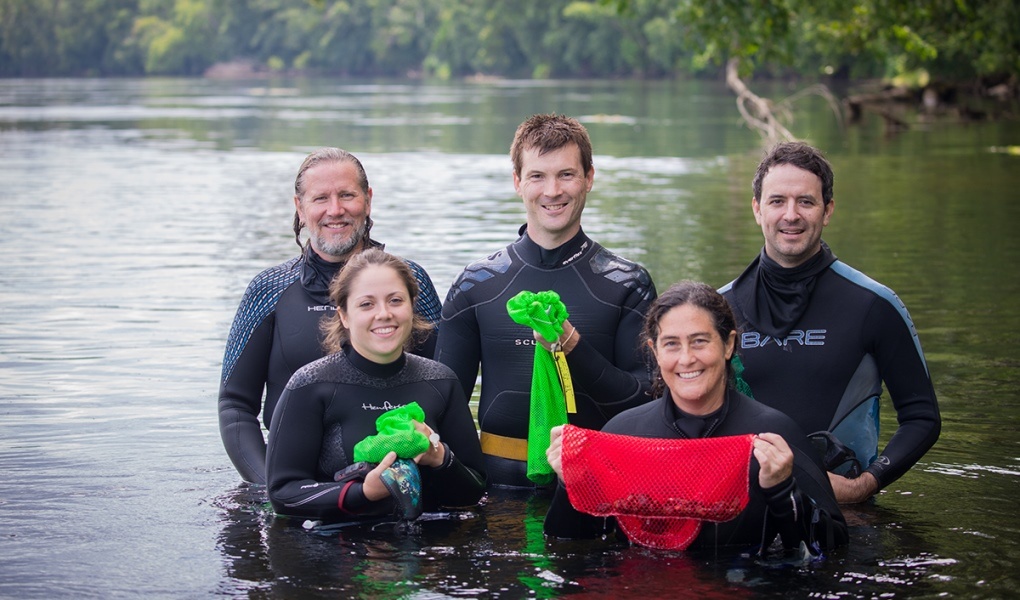In late 2022, freshwater mussel restoration in Virginia took a major step forward with new projects by the Chesapeake Bay Foundation (CBF) and the James River Association (JRA), supported by two grants from the National Fish and Wildlife Foundation (NFWF).
The projects follow a report issued last year that called for a comprehensive regional plan for mussel restoration to address dramatic declines in freshwater mussel populations in the Chesapeake Bay watershed.
 “Momentum is growing in Virginia to bring back these amazing freshwater mussels, but we hear time and again that we need a plan to focus these efforts,” said CBF Virginia Senior Scientist Joe Wood, Ph.D.
“Momentum is growing in Virginia to bring back these amazing freshwater mussels, but we hear time and again that we need a plan to focus these efforts,” said CBF Virginia Senior Scientist Joe Wood, Ph.D.
“Freshwater mussels are an important part of the Chesapeake Bay watershed’s natural heritage. These projects will set the stage for more freshwater mussels, cleaner water in fishing spots along our headwater streams, and a healthier Chesapeake Bay,” he explained.
The efforts by JRA and CBF would lay the groundwork for additional mussel restoration across the region through developing maps, plans, and identifying next steps.
Administered by the National Fish and Wildlife Foundation, these grants are supported by the first round of federal funding under the new Chesapeake WILD program.
About 23 species of mussels live in Virginia freshwater rivers and streams that flow into the Chesapeake Bay, from the James River to the Shenandoah Valley to small mountain streams.
But mussels are threatened by pollution, dams, climate change, viruses, and loss of habitat. Mussel populations in the Chesapeake Bay watershed are estimated to have fallen by 90 percent since European colonists arrived in the 1600s.
A single mussel can filter up to 15 gallons of water per day, which prevents pollutants such as nitrogen from flowing downstream, leading to clearer and cleaner water.
Mussel beds create habitat for small aquatic creatures, which in turn become food for fish.
For years, freshwater mussels have been raised and planted in rivers and streams by the Virginia Department of Wildlife Resources (DWR) and the U.S. Fish and Wildlife Service (USFWS).
That work has led to recent successes such as the re-introduction this year of the endangered James Spinymussel.
But mussel restoration in Virginia has been limited by scarce funding and the lack of a big-picture approach.
Under the grant, CBF is launching a project called Establishing a Plan for Freshwater Mussels: Protect, Restore, and Engage.
Together with the Virginia Department of Conservation and Recreation and DWR, CBF will create an interactive map of Virginia that highlights stretches of streams and rivers with critical freshwater mussel habitat, which will guide future restoration and conservation efforts.
The map will also show where buffers of trees along streams can best protect and revitalize mussel populations. Because work to plant forested buffers is increasing, this map can show where planting trees can most effectively lead to healthy streams.
To raise awareness about the rich diversity of mussels in Virginia, the project will create realistic 3D printed models of mussel shells representing all the species in the Chesapeake Bay watershed, working together with the Smithsonian Institution and Florida Museum of Natural History.
The scans will be open-source and available to everyone. A set of mussel models will be used in CBF’s award-winning environmental education programs.
“We are excited to receive one of the inaugural Chesapeake WILD grants. Healthy fish and wildlife habitat are vital to a healthy Bay ecosystem, and projects like these that put boots on the ground restoring habitats across the watershed are vital to saving the Bay and tributaries like the James River. CBF urges Congress to fully fund Chesapeake WILD when lawmakers reconvene in November to finish work on this year’s budget,” said CBF Interim Federal Director Keisha Sedlacek.
With its NFWF grant funding, JRA will work with experts from universities, state and federal agencies, private industry, and nonprofits on a collaborative project to Establish a Freshwater Mussel Restoration Plan in the James River Basin.
Over the past three years, JRA has partnered with DWR and the USFWS Harrison Lake Fish Hatchery to plant more than 10,000 freshwater mussels in the James River and its tributaries, conduct population assessments, and identify quality mussel habitat.
Through the course of this work, JRA recognized the need for a proactive restoration plan to guide planting activities, identify areas for further surveys and investigation, and establish strategic restoration objectives for the James.
“The success of our mussel planting work to date shows that it is possible to bring these unique species back to James River, with all of the water quality and habitat benefits that they provide,” said Erin Reilly, Senior Staff Scientist for the James River Association.
“This grant will buoy efforts to bring the experts together and chart a common course for mussel restoration in the James,” she added.
The plan will serve as an important tool for state agencies, federal hatcheries, nonprofits, the state legislature, and other funding agencies to determine where projects will be beneficial, facilitate planning, increase capacity, and drive research.
The collaborative process, and the resulting plan, will also serve as a model for other rivers across the state.
These projects are among the first under the Chesapeake WILD program, established by Congress in 2020 to support restoration efforts in the Chesapeake Bay watershed that improve the health of our streams and rivers and the aquatic life that calls them home.
Photos of James Spinymussel releases by Meghan Marchetti/Virginia DWR.

